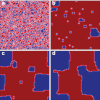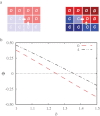Wisdom of groups promotes cooperation in evolutionary social dilemmas
- PMID: 22893854
- PMCID: PMC3418638
- DOI: 10.1038/srep00576
Wisdom of groups promotes cooperation in evolutionary social dilemmas
Abstract
Whether or not to change strategy depends not only on the personal success of each individual, but also on the success of others. Using this as motivation, we study the evolution of cooperation in games that describe social dilemmas, where the propensity to adopt a different strategy depends both on individual fitness as well as on the strategies of neighbors. Regardless of whether the evolutionary process is governed by pairwise or group interactions, we show that plugging into the "wisdom of groups" strongly promotes cooperative behavior. The more the wider knowledge is taken into account the more the evolution of defectors is impaired. We explain this by revealing a dynamically decelerated invasion process, by means of which interfaces separating different domains remain smooth and defectors therefore become unable to efficiently invade cooperators. This in turn invigorates spatial reciprocity and establishes decentralized decision making as very beneficial for resolving social dilemmas.
Figures







Similar articles
-
Defectors' intolerance of others promotes cooperation in the repeated public goods game with opting out.Sci Rep. 2020 Nov 11;10(1):19511. doi: 10.1038/s41598-020-76506-3. Sci Rep. 2020. PMID: 33177552 Free PMC article.
-
Generous cooperators can outperform non-generous cooperators when replacing a population of defectors.Theor Popul Biol. 2010 Jun;77(4):257-62. doi: 10.1016/j.tpb.2010.03.002. Epub 2010 Mar 10. Theor Popul Biol. 2010. PMID: 20226204
-
Decelerated invasion and waning-moon patterns in public goods games with delayed distribution.Phys Rev E Stat Nonlin Soft Matter Phys. 2013 May;87(5):054801. doi: 10.1103/PhysRevE.87.054801. Epub 2013 May 9. Phys Rev E Stat Nonlin Soft Matter Phys. 2013. PMID: 23767662
-
Universal scaling for the dilemma strength in evolutionary games.Phys Life Rev. 2015 Sep;14:1-30. doi: 10.1016/j.plrev.2015.04.033. Epub 2015 May 5. Phys Life Rev. 2015. PMID: 25979121 Review.
-
Cooperation in a generalized age-structured spatial game.J Theor Biol. 2020 Jan 7;484:109995. doi: 10.1016/j.jtbi.2019.109995. Epub 2019 Sep 3. J Theor Biol. 2020. PMID: 31491496 Review.
Cited by
-
Humans best judge how much to cooperate when facing hard problems in large groups.Sci Rep. 2019 Apr 2;9(1):5497. doi: 10.1038/s41598-019-41773-2. Sci Rep. 2019. PMID: 30940850 Free PMC article.
-
Modelling and computation in the valuation of carbon derivatives with stochastic convenience yields.PLoS One. 2015 May 26;10(5):e0125679. doi: 10.1371/journal.pone.0125679. eCollection 2015. PLoS One. 2015. PMID: 26010900 Free PMC article.
-
Open-minded imitation can achieve near-optimal vaccination coverage.J Math Biol. 2019 Sep;79(4):1491-1514. doi: 10.1007/s00285-019-01401-z. Epub 2019 Jul 20. J Math Biol. 2019. PMID: 31327021
-
Adaptive long-range migration promotes cooperation under tempting conditions.Sci Rep. 2013;3:2509. doi: 10.1038/srep02509. Sci Rep. 2013. PMID: 23974519 Free PMC article.
-
Reconstructing complex network for characterizing the time-varying causality evolution behavior of multivariate time series.Sci Rep. 2017 Sep 5;7(1):10486. doi: 10.1038/s41598-017-10759-3. Sci Rep. 2017. PMID: 28874713 Free PMC article.
References
-
- Nowak M. A. & Highfield R. SuperCooperators: Altruism, Evolution, and Why We Need Each Other to Succeed. Free Press, New York. (2011).
-
- Hrdy S. B. Mothers and Others: The Evolutionary Origins of Mutual Understanding. Harvard Univ. Press, Cambridge, Massachusetts. (2011).
-
- Bowles S. & Gintis H. A Cooperative Species: Human Reciprocity and Its Evolution. Princeton Univ. Press, Princeton, NJ. (2011).
-
- Asch S. E. Opinions and social pressure. Sci. Am. 193, 31–35 (1955).
-
- Surowiecki J. The Wisdom of Crowds: Why the Many Are Smarter than the Few and How Collective Wisdom Shapes Business, Economies, Societies, and Nations. Random House, New York, US. (2004).
Publication types
MeSH terms
LinkOut - more resources
Full Text Sources

